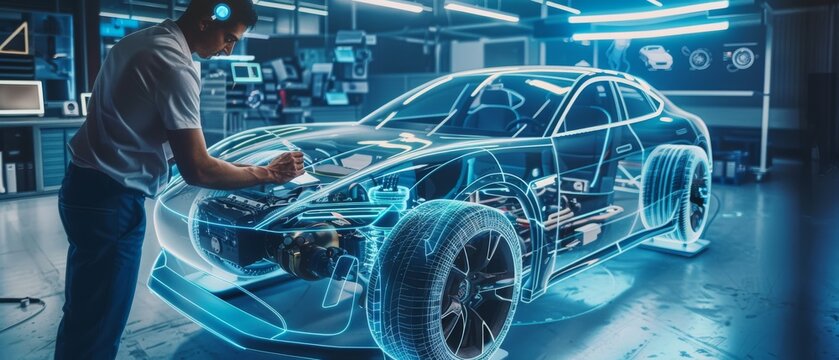Augmented Reality (AR) is revolutionizing the automotive industry by enhancing design, prototyping, manufacturing, and maintenance processes. It allows engineers and designers to visualize concepts in real-time 3D, improving accuracy, efficiency, and collaboration. By overlaying digital models on physical environments, AR accelerates the development cycle and minimizes costly errors in vehicle production.
Key Applications of AR in Automotive Design and Engineering
1. AR-Driven Conceptual Design and Prototyping
- AR enables virtual vehicle modeling, allowing designers to interact with life-sized holograms instead of traditional 2D sketches.
- Real-time modifications and instant visualization of design changes eliminate the need for multiple physical prototypes.
- Example: Ford’s design team uses AR headsets to overlay digital car models onto physical prototypes, enabling rapid iteration and refinement.
2. Enhancing Vehicle Aerodynamics and Structural Engineering
- AR simulations analyze airflow over a virtual car body, identifying areas for aerodynamic improvement before wind tunnel testing.
- Engineers can explore internal structures and materials without disassembling a vehicle, optimizing chassis design and crash safety.
- Example: BMW integrates AR-assisted wind tunnel simulations, reducing the time and cost of aerodynamic testing.
3. AR-Assisted Assembly and Manufacturing Optimization
- Factory workers use AR-guided instructions via smart glasses to assemble complex components with precision.
- AR overlays provide real-time quality control, highlighting errors and reducing manufacturing defects.
- Example: Porsche uses AR-based workstations to help technicians install complex wiring and electronic systems in luxury vehicles.
4. Streamlining Collaborative Engineering and Remote Design Reviews
- AR enables real-time collaboration between engineers across different locations by sharing interactive 3D models.
- Stakeholders can review design elements in virtual reality (VR) showrooms, eliminating the need for physical meetings.
- Example: Volkswagen uses Microsoft HoloLens for remote engineering reviews, accelerating global R&D coordination.
5. Augmented Reality for Vehicle Testing and Safety Simulations
- AR simulates crash tests and durability assessments, allowing engineers to refine vehicle safety before physical testing.
- Virtual overlays provide live sensor data during road tests, helping engineers fine-tune suspension, braking, and stability systems.
- Example: Mercedes-Benz leverages AR simulations for predictive crash testing, reducing the reliance on costly crash dummies.
6. AR-Enhanced Training for Automotive Technicians
- AR-based training modules guide mechanics through step-by-step repair procedures, minimizing errors in vehicle servicing.
- Virtual overlays highlight engine components, allowing trainees to disassemble and reassemble parts in a simulated environment.
- Example: Audi Service uses AR to provide interactive repair tutorials, improving technician efficiency.
7. Augmented Reality for Smart Showrooms and Customer Experience
- AR allows customers to visualize car models in different colors, trims, and configurations before purchasing.
- Interactive AR displays provide insights into engine specifications, safety features, and interior designs in real-time.
- Example: Volvo uses AR-based virtual showrooms, enabling customers to explore vehicles without a physical dealership visit.
Challenges and Considerations in AR Implementation
1. High Implementation Costs
- Developing AR hardware and software requires substantial investment, limiting adoption for smaller manufacturers.
- Cloud computing and AI-driven AR applications are helping reduce costs over time.
2. Data Accuracy and Processing Limitations
- AR models rely on precise data synchronization; any misalignment can lead to inaccurate visualizations.
- AI-powered calibration techniques improve AR accuracy in automotive design.
3. Compatibility with Existing Workflows
- Many manufacturers use traditional CAD software, making seamless integration with AR platforms a challenge.
- Industry-wide adoption of AR-compatible design tools is essential for widespread implementation.
Future of AR in Automotive Engineering
- AI-driven AR will further enhance vehicle diagnostics, allowing real-time damage detection and automated design recommendations.
- Holographic windshields will provide real-time navigation overlays, enhancing driver safety and in-car infotainment.
- 5G-enabled AR collaboration will enable designers, engineers, and manufacturers to work in real-time virtual environments.
As AR continues to evolve, it will streamline automotive design, improve production efficiency, and redefine customer engagement, positioning itself as a game-changer in the future of mobility.
From Our Editorial Team
Our Editorial team comprises of over 15 highly motivated bunch of individuals, who work tirelessly to get the most sought after curated content for our subscribers.


